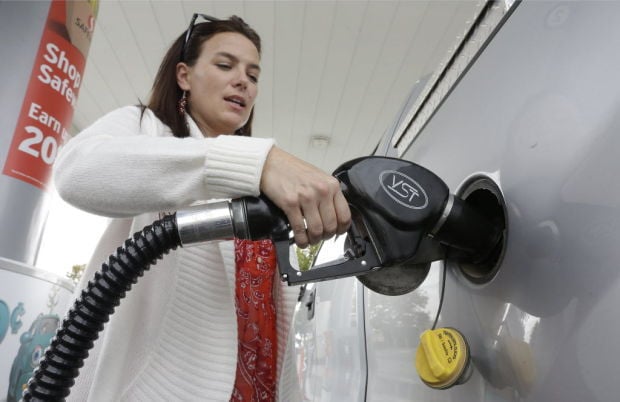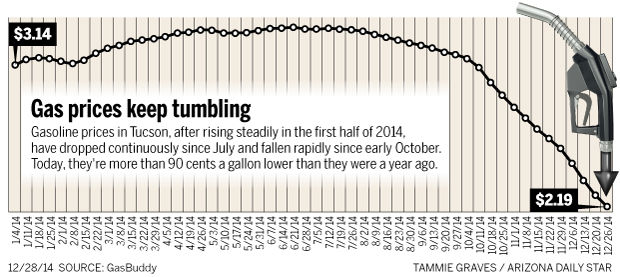The economic upsides of low gasoline prices are immediate: More cash for consumers to spend. Faster economic growth. More U.S. clout overseas. A decline in the power of OPEC.
The potential environmental downsides are more distant, but early hints at them are appearing:
• Sales of SUVs have spiked nationally as sales of fuel-efficient new vehicles are down.
• The number of miles driven nationally surged 2.6 percent in October versus the same month last year — the fastest such increase in recent memory — and Arizonans purchased more gasoline this fall than they did last fall.
• The American Automobile Association predicts an increase in holiday-season automobile travel in Arizona and nationally because of lower gas prices and a better economy.
Many studies have shown that gas price elasticity — the amount drivers change their habits in response to gas prices — is fairly low in the short term, said Ashley Langer, an assistant economics professor at the University of Arizona economics who researches transportation and energy economics. But if gas prices stay low, it will have a more significant effect on driving, vehicle purchases and possibly housing choices, she said.
“In the ’70s and ’80s, elasticity was higher. It’s a question of have we gotten numbed to some of it,” Langer said. “We live now in a more suburban world, where no switching (to other forms of transportation) is possible. We have national fuel economy standards in cars. The change in prices doesn’t affect your pocketbook as much.”
With gas prices low and the economy good, people may plan vacations farther out in the future and decide to drive to the Grand Canyon instead of doing something else, she said. Also, if you’re thinking about buying your first house, “Oro Valley looks a lot more attractive, at least in a year from now and maybe longer.”
In the immediate future, low gas prices will cause more gas consumption simply because people will have more money to travel, added Arthur Nelson, an associate dean and professor at the UA’s College of Architecture, Planning and Landscape Architecture. As fuel prices fall, demand for air travel will increase in theory, although the airline industry may have consolidated so much that airfares may not fall that much, he said.
If lower gas prices do boost gasoline use and air pollution, it is a concern for Pima County environmental officials. That’s because the county already is close to being out of compliance with federal air quality standards for ozone, the main ingredient in smog, said Beth Gorman, a Pima County Department of Environmental Quality program manager.
Every gallon of gasoline burned puts 1.12 pounds of conventional pollutants into the air, says the regional Pima Association of Governments, based on a computer-based forecasting model. Carbon monoxide accounts for 1 pound. The rest comes from nitrogen oxide, volatile organic compounds and particulate matter.
In addition, burning that same gallon of gasoline emits 20 pounds of carbon dioxide, a greenhouse gas that the overwhelming majority of climate scientists have linked to global warming.
Here are some ways lower gas prices can affect the environment:
SUV sales
With fuel prices at a four-year low and falling, U.S. auto sales rose 4.6 percent nationally in November, Bloomberg News reported. Drivers opted for big expensive models like the Cadillac Escalade, which surged 91 percent last month in sales, and the Lincoln Navigator, up 88 percent. They have less interest in small economy cars such as the Ford Fiesta, off 26 percent last month, and hybrids like the Toyota Prius, down 14 percent. Electric vehicles in general could have problems with the lower gas prices, Bloomberg and The Washington Post reported.
In Tucson, only two of more than a half-dozen car dealerships contacted by the Star responded to inquiries about their sales in light of lower gas prices. Jim Click’s 10 dealerships here reported that sales of SUVs and large trucks such as the Ford Explorer and Dodge Ram have risen 25 percent this month from December 2013, but that sales of smaller, more fuel-efficient vehicles have doubled in that same time frame. Auto Nation Honda reported no big increase in large vehicle sales.
“Normally when gas prices drop, we sell more of the bigger vehicles. This time it’s working its way on both ends,” said Sam Khayat, chief operations officer for Click’s dealerships. “I think what’s happening is people think, “Well, heck, why not? I’m already saving. This is a better deal.”
Nationally, however, the average fuel economy of new vehicles sold dropped a half-mile per gallon to 25.3 mpg from August to September and stayed there through November, the University of Michigan’s Transportation Research Institute reported.
In 2012, a national study by three economists concluded that not only did the share of fuel-efficient cars sold rise sharply after gas prices shot up $1 a gallon in 2008, but that when the prices dropped for even one month, consumers shifted back toward SUVs.
“When consumers are buying a car, they take whatever the current gas price is — that’s what they believe will be the price over the life of the car,” said MIT economist Chris Knittel, a co-author of the report.
Miles of driving
Vehicle miles traveled in Arizona and nationally started tumbling even before the financial crisis and recession of 2007-08. The number of vehicle miles traveled both statewide and nationally have bumped up and down since then but have lagged behind population growth rates.
The Arizona Public Interest Research Group noted those trends in a report earlier this year that said state and local transportation planners should heed them in planning for more mass transit use in the future.
Now, the research group acknowledges that driving could increase, but Arizona PIRG Director Diane Brown added, “This does not mean a return to the old driving boom. Over the longer term, gas prices matter more as people make decisions about where to live, how to commute and what kind of car to buy. All else equal, a faster-growing economy means more commerce and more people commuting — thus somewhat more driving.” But the once-tight relationship between gross domestic product and vehicle miles traveled ended in the mid-1990s, she said.
Brown points to a new report from the U.S. Energy Information Administration that said it takes a 25 to 50 percent decrease in gasoline prices to boost auto travel 1 percent. Back in the mid-1990s, it took only a 12 percent decrease in gas prices to boost sales 1 percent, the federal agency said.
But in a 2009 study, researchers Daniel Kaffine of the University of Colorado and Nicholas Burger of the Rand Corporation concluded that on the congested Los Angeles freeway system, it only took a 10 percent boost in gas prices to reduce travel demand by 1 percent. A $1-per-gallon gas price increase reduced demand enough on congested stretches that drivers could speed up an average of 3 miles an hour.
Overall, the energy administration’s estimate of how much consumers respond to gas prices is “on the low side” compared to even very recent research, said Kaffine, an economics professor.
Transit
So far, there’s no evidence that lower gas prices have hurt transit ridership here or nationally.
In Tucson, Sun Tran ridership rose in four of the first five months of the current 2014-15 fiscal year compared to the same months a year earlier, after having dropped from a peak in 2009-10.
Streetcar ridership was about 107,000 in November, down 17 percent from a September peak. It’s difficult to determine how gas prices are affecting that because it’s the first year of streetcar service, so no older numbers exist for comparison, said Jeremy Papuga, the city of Tucson’s transit administrator.
Nationally, transit ridership from July through September 2014 rose 1.8 percent from that period of 2013, said the American Public Transit Association, a transit advocacy group.
Where to live
When gas prices approached $4 a gallon in 2008, researcher Nelson was one of many observers to predict it would discourage homebuyers from moving to far-flung suburbs.
Last week, Nelson said he believes gas prices did discourage suburban and exurban housing demand since then. But so did tighter mortgage underwriting rules after the financial crisis, declining consumer purchasing power and changing consumer tastes in homebuying.
Looking ahead, “Mortgage underwriting and incomes will be a better predictor of suburban fringe demand than gasoline prices. Frankly, it always was,” said Nelson, a land-use scholar who came to the UA last May from the University of Utah.
If there were a connection between gas prices and suburban home sales, we would be seeing an increase in such sales now in Tucson, “but we haven’t and I don’t think we will” any time soon, added Ginger Kneup, owner of Tucson real estate consultants Bright Future Real Estate Research. “It’s going to take a long time and lots of forces in the economy, one of which is gas prices, to affect home sales.”







